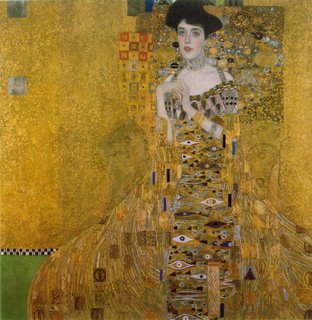Saliera, by Benvenuto Cellini. Gold, enamel and ebony, 1540-1543.

Speaking of gold, and art theft, today's featured work of art is the world's most famous salt shaker: the piece above, known as the Saliera. Okay, so it's obviously not a shaker. The salt goes in that round bowl in the back, and the little arched temple in the front is there to hold the pepper. (I'm not making this up, I swear.) Technically, this thing is called a salt cellar. So the next time your fabulously wealthy friends invite you over for dinner, and they're too posh to have normal old salt shakers, you can say, "Pass the salt cellar please, my good man," and not look too stupid.
This salt cellar is the work of Benvenuto Cellini, a mannerist sculptor with a bit of an eccentric personality. He murdered a few people, was often in prison - and he actually brags about all of this in his autobiography. He did do one thing worth bragging about: when he was imprisoned in Rome's Castel Sant'Angelo (a.k.a. Hadrian's tomb), he broke out by climbing down a rope made out of bedsheets he had tied together. (And you thought that only happened in the movies.) Cellini also claimed to be a great lover, an opium-eater, and a necromancer. Your typical Renaissance fare, I suppose. (Ha, excuse the pun, it was unintentional.)
Cellini's wild life aside, he was quite the artist, and did a lot of work for royalty. He briefly studied under Michelangelo, and went on to work for the famous Cosimo d'Medici, King Francis I of France, and Popes Clement VII and Paul III.
Cellini made Saliera for King Francis I. He brags in his autobiography that when he first showed it to the king, Francis couldn't take his eyes off of it. He explains, "In order to show how the sea is connected with the Earth, I made two figures, a good palms width in height, which sat across from each other with legs crossed, just as one sees the arms of the sea flowing into the land. The sea, depicted as a man, holds a richly decorated ship, which can hold salt enough; beneath it I mounted four seahorses and put a trident in the figures right hand. The Earth I depicted as a woman, of such lovely form and as graceful as I knew how to create. Next to her I placed on the ground a richly decorated temple, which was intended to hold pepper.... At her side were the loveliest creatures the Earth produces."
You might be surprised by just how famous Saliera is. The House of Faberge made some amazingly opulent stuff for Russian royalty, but no single Faberge work carries this much fame. This made it all the more appalling when it was stolen from Austria's Art History Museum back in May 2003. Thieves broke into the museum around 4 AM, smashed the case Saliera was in, and took off with it. The alarms went off, but the unfortunate security guard on duty assumed the alarm had been false - nobody realized what had happened until about 9 that morning.
Luckily, Saliera is a famous enough work of art that not even buyers on the black market would risk buying it. It would be too risky to display it, even in a private home. When it was stolen, various groups tried to estimate just how much it was worth - most estimates came in around $55 million, but auction house Sotheby's argued that that price was much too low, and the real value was probably in the hundreds of millions.
In January 2006 the Austrian police finally found Saliera when one of the thieves tried to put it up for ransom - police followed him into the forest and found the spot where he had buried it. Personally, I would have gone for a Swiss bank, but I guess burying the thing works, too. It suffered no damage, and is now back on display. If you have any interest in stolen art, I suggest you check out Interpol's webpage on stolen art, or the website of the FBI's recently created Art Crime Team.







